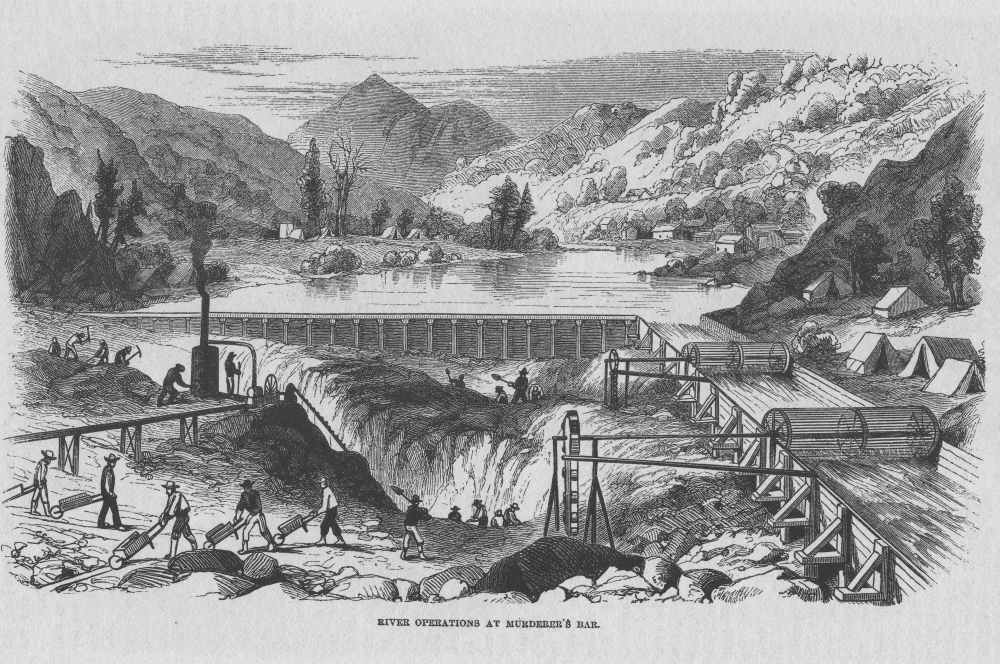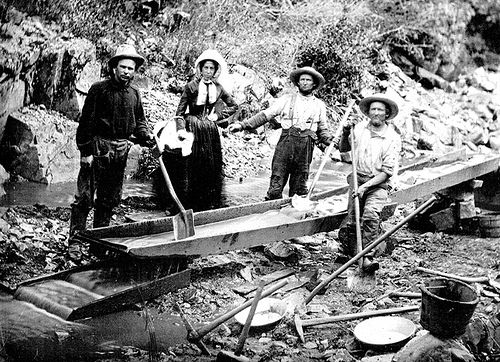
Seeking gold in the California river
Source: Harper’s Weekly magazine
On August 19, 1848, the the New York Herald, a major newspaper of the American East Coast printed the exciting news that gold has been found on the West Coast, which caused thousands of immigrants from all over the world to travel to California hoping to to find wealth and glory.
The 1848 Gold Rush and How it all began
The story began some months earlier, in January 1848. James Marshall constructed a saw mill for the pioneer John Sutter at the American River and discovered the first gold. Unfortunately nobody believed in the articles the San Francisco newspapers published about these findings until May of the same year when a storekeeper ran around the city with a bottle full of gold dust proving the rumors right. The big immigrant wave arrived after the New York Herald published its article and many people around the country left their jobs and families to search for gold.
Not a Walk in the Park
As easy as it sounds today traveling to California, in the middle of the 19th century it was not a walk in the park. Some traveled by sea which took several months. The most famous land route was the California Trail, a route of 3,200km across the western half of the United States. Either way, the travelers had to face fever, cholera, and often death. Still, most of them made it to San Francisco, which caused the city to grow from about 1,000 citizens up to 25,000 in between two years.

A woman with three men panning for gold during the California Gold Rush
The 49-ers
The big amount of 49-ers (as the gold seekers were called) caused many structural and political problems. First of all, the new citizens had to be supplied with food and it sometimes took too long for the merchant ships to arrive. Also many disagreements between Americans and foreigners began and resulted in cruel attacks from American prospectors against mainly the Mexican and Chinese workers. Soon, foreigners had to pay a ridiculously high tax to being able to seek for gold. Native Americans also faced bad times, they were pushed out of their hunting areas and starved to death, others were slaughtered and over the years more than 100,000 Native Americans were killed as a result of the Gold-Rush.
The Life in Camps
After a short time, the gold that could basically just be collected from the ground was gone and the 49-ers had to come up with new techniques that were more of hard work and also very pricy so that many had to receive loans from the bank or were forced to work together. These circumstances affected the life in the camps the gold diggers were living in were described by Mr. Shufelt, one of the many 49-ers:
“Many, very many, that come here meet with bad success & thousands will leave their bones here. Others will lose their health, contract diseases that they will carry to their graves with them. Some will have to beg their way home, & probably one half that come here will never make enough to carry them back. But this does not alter the fact about the gold being plenty here, but shows what a poor frail being man is, how liable to disappointments, disease and death.”
Modest Profit
The overall profit of the miners was rather modest in contrast to the many merchants settling in the new cities, one of them was the famous Levi Strauss selling denim overalls. The California Gold-Rush indeed stimulated the economy, let the cities grow fast and was the reason for several technical inventions as well as the construction of schools, roads and train routes.
The Effect on California
The uncontrolled immigration of people also caused great problems: San Francisco burned six times between 1849 and 1851. The hygienic conditions were catastrophic, fleas and rats spread. A cholera epidemic broke out in the winter of 1851. At the beginning of the Spanish Mission, the indigenous population of California was estimated at around 310,000. At the end of the Mexican era, before the gold rush, only about 150,000 Indians lived on the territory of the later state. By 1870, only 31,000 had remained. In contrast, the development of the inhabitants of European descent stood in contrast: For 1850, the US administration registered a total population of California of about 92,000, which by 1870 had risen to about 560,000 inhabitants. More than 60 percent of the Indians had died of diseases brought by gold prospectors. Countless Indians were driven off their land and massacred. On scalps of Indians, premiums were suspended, children of Indians were sold like slaves. During the extraction of gold, over 7,000 tons of mercury were released, poisoning rivers and lakes. Because of its wealth and its rapidly growing population, California became the 31st state to join the Union (USA) on September 9, 1850.
Elliott West, Lectures in History: California Gold Rush Environmental Impact, [7]
References and Further Reading:
- [1] Joaquin Miller, Life Amongst the Modocs: Unwritten History
, Heyday Books, 1996
- [2] Hinton Rowan, The Land of Gold Reality Versus Fiction
, BiblioBazaar, 2009
- [3] The Gold Rush at calgoldrush.com
- [4] California Gold-Rush at Wikidata
- [5] The California Gold-Rush at Eye Witness to History
- [6] California State Library, “California As We Saw It”: Exploring the California Gold Rush, online exhibit
- [7] Elliott West, Lectures in History: California Gold Rush Environmental Impact, 2019, American History TV C-SPAN @ youtube
- [8] Timeline of California Pre-State History, via Wikidata and DBpedia






This comment has been removed by a blog administrator.
This post was truly worthwhile to read. I wanted to say thank you for the key points you have pointed out as they are enlightening.